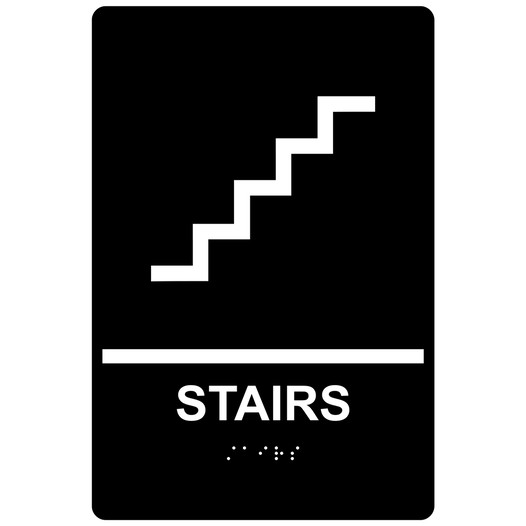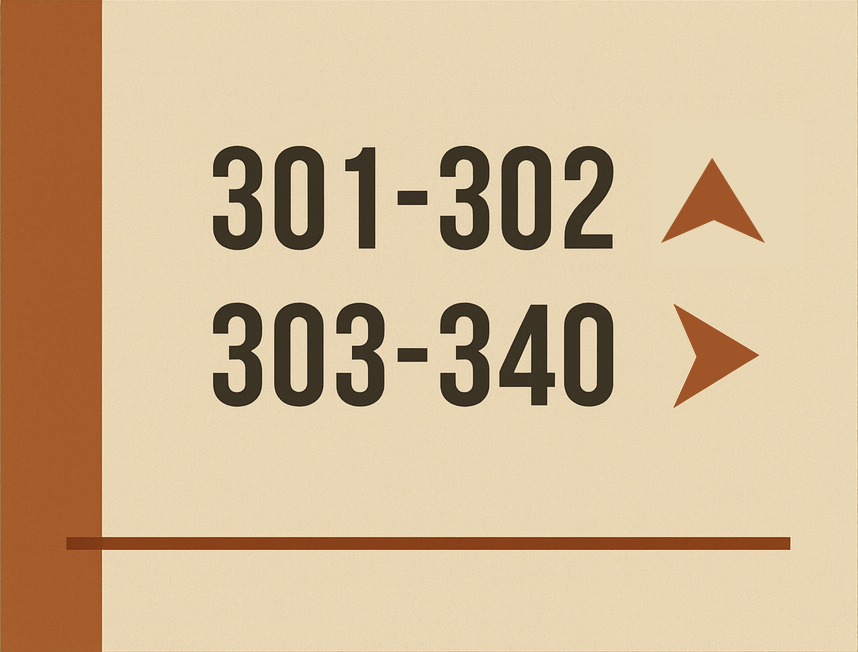Navigating ADA compliance for architectural signage can be complex, but understanding the requirements is essential for any project manager or architect working with sign vendors. This comprehensive guide breaks down the key regulations, requirements, and best practices to ensure your signage meets all accessibility standards.
Essential ADA Requirements
For identification signs (room names, spaces), you need:
-
•
Raised characters + Braille (informational/directional signs don't need Braille)
28 CFR § 36.216(a), 2010 ADA Standards § 216.2, § 703.1
-
•
5/8" to 2" character height, sans serif, ALL UPPERCASE
2010 ADA Standards § 703.2.2, § 703.2.3, § 703.2.5
-
•
High contrast colors with non-glare finish
2010 ADA Standards § 703.6.2
-
•
48-60" mounting height to baseline of characters
2010 ADA Standards § 703.4.1
-
•
Pictograms in 6" field (add ISA symbol if accessible)
2010 ADA Standards § 703.6.1
ADA Sign Requirements Quick Reference
Use this comprehensive table to quickly determine requirements for different sign types.
| Requirement | Identification Signs | Informational Signs | Directional Signs | Overhead Signs |
|---|---|---|---|---|
| Braille Required | ✓ Required | ✗ Not Required | ✗ Not Required | ✗ Not Required |
| Raised Characters | ✓ Required | ✗ Not Required | ✗ Not Required | ✗ Not Required |
| Font Type | Sans Serif Only | Simple or Sans Serif | Simple or Sans Serif | Simple or Sans Serif |
| Character Case | ALL UPPERCASE | Upper and/or Lower | Upper and/or Lower | Upper and/or Lower |
| Pictograms | 6" High Field Required | No Specific Requirement | No Specific Requirement | No Specific Requirement |
| Minimum Height | 5/8" to 2" | 5/8" minimum | 5/8" minimum | 2" minimum |
| Mounting Height | 48" to 60" | No Specific | No Specific | 80" minimum clearance |
| Legal Reference | § 216.2, § 703.1 | § 703.6.2 | § 703.6.2 | § 703.6.2 |
Four Basic ADA Sign Types
ADA regulations cover four basic sign types, each with different requirements. Understanding these categories is crucial for proper specification and compliance.


Identification Signs
Signs that identify a room, space or area.
Requirements:
- Braille: Yes
- Raised Lettering: Yes
- Font: Sans Serif
- Case: All Uppercase
- Pictograms: Yes (6" field)
Informational Signs
Signs that provide information about a room, space or area.
Requirements:
- Braille: No
- Raised Lettering: Not Required
- Font: Simple or Sans Serif
- Case: Upper and/or Lower
- Pictograms: No Specific Requirement

Directional Signs
Signs that provide direction to a room, space or area.
Requirements:
- Braille: No
- Raised Lettering: Not Required
- Font: Simple or Sans Serif
- Case: Upper and/or Lower
- Pictograms: No Specific Requirement
Overhead Signs
Wall, ceiling and projection type signs mounted overhead.
Requirements:
- Braille: No
- Raised Lettering: Not Required
- Font: Simple or Sans Serif
- Case: Upper and/or Lower
- Mounting: Min Clearance 80"
Character Specifications and Requirements
Character specifications are critical for ADA compliance. These requirements ensure readability and accessibility for all users.
Character Height, Proportions and Spacing Requirements
Character specifications are determined by mounting height and reading distance. These requirements ensure optimal readability and accessibility.
Character Height Requirements - Sign Mounted between 40-70"
| Reading Distance | Minimum Letter Height |
|---|---|
| Under 6 Feet | 5/8" |
| 7 Feet | 3/4" |
| 8-9 Feet | 1" |
| 10-11 Feet | 1.25" |
| 12-13 Feet | 1.5" |
| 14-15 Feet | 1.75" |
Character Proportions and Spacing Requirements:
- Character Width: 55-110% of character height
- Character Spacing: Minimum 1/8" between characters
- Line Spacing: 35-70% of character height
- Character Stroke: Maximum 15% of character height
- Margins: 3/8" minimum around all raised elements
Comprehensive Character Specifications Table
| Specification | Requirement | Range/Limit | Legal Reference |
|---|---|---|---|
| Character Height | Minimum height based on viewing distance | 5/8" to 2" maximum | § 703.2.5 |
| Character Width | Proportional to height | 55-110% of height | § 703.2.4 |
| Character Spacing | Minimum spacing between characters | 1/8" minimum | § 703.2.7 |
| Line Spacing | Spacing between text lines | 35-70% of character height | § 703.2.7 |
| Character Stroke | Thickness of character lines | Maximum 15% of height | § 703.2.6 |
| Margins | Space around raised elements | 3/8" minimum | § 703.2.7 |
| Font Style | Type of font required | Sans serif only | § 703.2.3 |
| Character Case | Uppercase requirement | All uppercase | § 703.2.2 |
Braille Requirements and Specifications
Braille is required for identification signs and must meet specific size and spacing requirements.
Braille Size and Spacing
- Dot Diameter: 0.060" at base
- Dot Height: 0.025"
- Cell Spacing: 0.3" between cells
- Dot Spacing: 0.1" between Braille dots
- Line Spacing: 0.4" between Braille lines
- Shape: Distinct dome shaped
Braille Positioning
- Distance from Text: 3/8" to 1/2" below last line of raised text
- Grouping: All Braille must be grouped together
- Case: Lowercase, except for proper names and acronyms
- Space Required: 1" high space for one line of Braille
- Grade: Grade II Braille (Contracted, Abbreviated)
Mounting Requirements and Specifications
Proper mounting is crucial for accessibility and compliance. These requirements ensure signs are accessible to all users.
Room and Space Signs
- Mounting Height: 48" to 60" above floor to baseline of characters
- Location: Latch side of door
- Double Doors: Mount on right side when both leafs are active
- Wall Space: Use nearest adjacent wall if insufficient space
- Clear Floor Space: 18" minimum by 18" minimum, centered on tactile characters
Overhead Signs
- Minimum Clearance: 80" from bottom of sign to floor
- Mounting Types: Wall, ceiling, or projection mounted
- Accessibility: Must be readable from standing position
Color and Contrast Requirements
All ADA signs must have good contrast between background and character colors, with a non-glare finish.
Standard Color Combinations
These color combinations meet ADA contrast guidelines:
Finish Requirements
Non-glare finish required with good contrast. Avoid glossy or reflective materials.
Pictogram and Symbol Requirements
Pictograms used in identifying a room or space have specific requirements for size and positioning.
Required Pictograms
- Field Height: Minimum 6" high field required
- Isolation: No other elements should be within this space
- Text Position: Corresponding text with Braille directly below
- ISA Symbol: Include if accessible
Pictogram Categories
- Required: Restroom, exit, accessible entrance
- Recommended: Room identification pictograms
- Optional: Directional and informational pictograms
Best Practices for ADA Compliance
Beyond meeting minimum requirements, these best practices ensure optimal accessibility and user experience.
Design Recommendations
- Use 3/4" minimum letter height for better readability
- Provide adequate spacing between characters and lines
- Choose high-contrast color combinations
- Use consistent terminology throughout the facility
- Consider multilingual requirements for diverse populations
Installation Best Practices
- Test mounting locations before final installation
- Ensure clear floor space is not obstructed
- Verify proper mounting height and positioning
- Check for glare and visibility issues
- Document installation for future reference
Maintenance Considerations
- Regular cleaning to maintain contrast
- Inspect for damage or wear
- Replace signs that become illegible
- Keep installation records updated
- Train staff on accessibility requirements
State and Local Code Variations
While federal ADA requirements provide the baseline, state and local codes may have additional or modified requirements.
Common State Variations
- California: Additional requirements for restroom door signs
- New York: Enhanced contrast requirements
- Texas: Specific mounting height variations
- Florida: Hurricane-resistant mounting requirements
Local Building Codes
- Fire safety requirements
- Emergency egress signage
- Energy efficiency standards
- Material durability requirements
Important
Check with state/local building officials and ADA specialists for final compliance verification. Local regulations may vary or supersede federal laws.
Conclusion
ADA compliance for architectural signage is not just about meeting legal requirements—it's about creating inclusive, accessible environments for all users. By understanding and implementing these guidelines, project managers and architects can ensure their signage systems serve everyone effectively.
Remember that ADA compliance is an ongoing process. Regular reviews, updates, and maintenance ensure that your signage continues to meet accessibility standards and provides the best possible experience for all users.